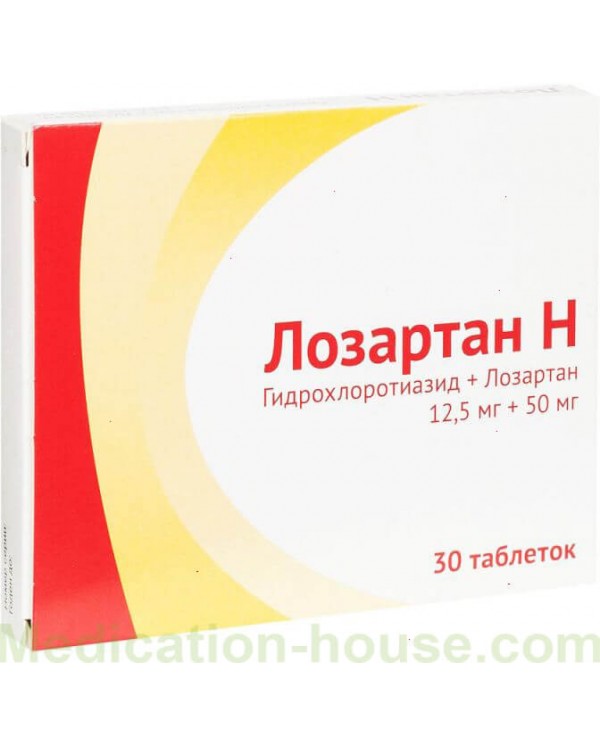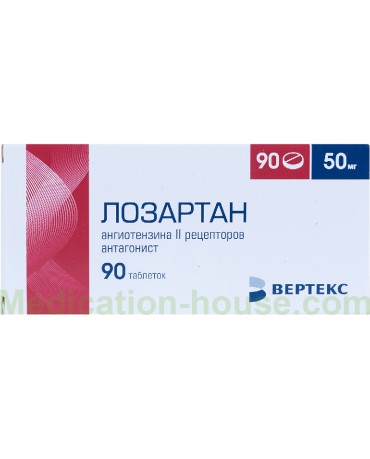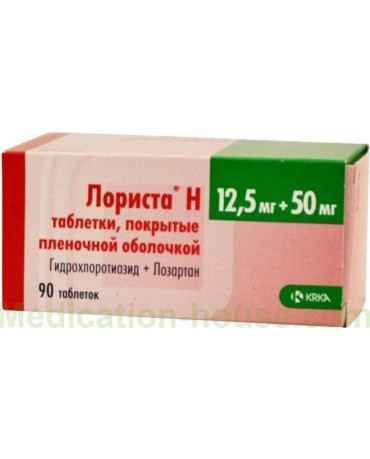Instruction for Losartan H
Reed more and buy Losartan H on this page
Losartan H is a combined antihypertensive drug (diuretic + angiotensin II receptor blocker).
Release form and composition
The drug is produced in the form of film-coated tablets: round, biconvex, light yellow with a beige tint or light yellow, the core is almost white: on tablets with a dosage of 100 + 25 mg, there is a risk on one side (7, 10, 14, 25 or 30 pcs. In blisters, in a cardboard box 1, 2, 3, 4, 5, 6, 7, 8, 9 or 10 blisters; 10, 14, 20, 28, 30, 40, 50, 56 each , 60, 90 or 100 pieces in polyethylene cans, in a cardboard box 1 can Each box also contains instructions for the use of Losartan H).
Composition for 1 tablet 12.5 + 50 / 12.5 + 100/25 + 100 mg:
active ingredients: hydrochlorothiazide - 12.5 / 12.5 / 25 mg + potassium losartan - 50/100/100 mg;
auxiliary components: lactose monohydrate (milk sugar), colloidal silicon dioxide, sodium carboxymethyl starch, microcrystalline cellulose, povidone K25, magnesium stearate;
film shell: macrogol-4000, hypromellose, iron dye yellow oxide, titanium dioxide.
Pharmacodynamics
Losartan H is a combined antihypertensive drug. The additive effect of its active components contributes to a more pronounced decrease in blood pressure (BP) than the action of losartan and hydrochlorothiazide separately.
Losartan is a selective angiotensin II receptor antagonist (type AT1) for oral administration. The action of losartan and its active metabolite E-3174 blocks all physiologically significant effects of angiotensin II (regardless of the pathway of its synthesis) on AT1 receptors. This leads to an increase in plasma renin activity, a decrease in the level of aldosterone concentration in blood plasma. By increasing the concentration of angiotensin II, losartan indirectly promotes the activation of AT2 receptors. Reduces OPSS (total peripheral vascular resistance), pressure in the pulmonary circulation and afterload on the myocardium, has a diuretic effect. With CHF (chronic heart failure), it increases exercise tolerance, prevents the development of myocardial hypertrophy. Does not have a clinically significant effect on heart rate (heart rate), does not suppress kininase II activity. Has a moderate and transient uricosuric effect. The use of losartan once a day provides a statistically significant decrease in systolic and diastolic blood pressure. With uniform blood pressure control throughout the day, the antihypertensive effect corresponds to the natural circadian rhythm. The decrease in blood pressure at the end of the period of action of the dose of losartan corresponds to 70-80% of its maximum effect 5-6 hours after ingestion. There is no withdrawal syndrome.
Hydrochlorothiazide is a thiazide diuretic with antihypertensive effects. Its action is due to the ability to disrupt the reabsorption of sodium, potassium, magnesium, chlorine and water ions in the distal nephron. Delays the excretion of uric acid, calcium ions. The antihypertensive effect develops against the background of the expansion of arterioles, has practically no effect on normal blood pressure. The diuretic effect is observed after 1–2 hours, the maximum reaches after 4 hours and lasts 6–12 hours. The maximum antihypertensive effect occurs after 3–4 days of therapy; it may take 21–28 days to achieve the optimal therapeutic effect.
The diuretic effect of hydrochlorothiazide increases the activity of plasma renin, increases the concentration of angiotensin II, stimulates the secretion of aldosterone, lowers the level of potassium in the blood plasma, and causes a slight increase in the concentration of uric acid in the blood. Against the background of its combination with losartan, potassium loss and the severity of hyperuricemia decrease.
Pharmacokinetics
After taking the tablet inside, losartan is actively absorbed from the gastrointestinal tract (GIT), bioavailability is approximately 33%. During the first passage through the liver, it is significantly biotransformed with the formation of an active carboxylated metabolite (E-3174) and inactive metabolites. The maximum plasma concentration (Cmax) of losartan is reached after 1 hour, its active metabolite - after 3-4 hours. When taken in doses up to 200 mg, they are characterized by linear pharmacokinetics.
Hydrochlorothiazide is absorbed by 60–80% of the dose taken. Cmax is reached after 1-5 hours.
Plasma protein binding: losartan and E-3174 (mainly with albumin) - more than 99%, hydrochlorothiazide - 64%.
The volume of distribution of losartan is 34 liters.
Losartan poorly crosses the blood-brain barrier. Hydrochlorothiazide crosses the placental barrier and is excreted in breast milk.
Hydrochlorothiazide is not metabolized. Its half-life (T1 / 2) is 5-15 hours. It is rapidly excreted through the kidneys, at least 61% unchanged.
Plasma clearance of losartan is 10 ml / sec, E-3174 - 0.83 ml / sec, renal clearance - about 1.23 ml / sec and 0.43 ml / sec, respectively. T1 / 2 of losartan - 2 hours, its active metabolite - 6-9 hours. Does not cumulate. 58% of the dose taken is excreted through the intestines, 35% through the kidneys.
Indications for use
arterial hypertension in patients requiring combination therapy;
reducing the risk of associated cardiovascular pathologies and mortality in arterial hypertension and left ventricular hypertrophy.
Contraindications
Absolute:
renal failure with creatinine clearance (CC) less than 30 ml / min;
anuria;
severe liver dysfunction;
the period of pregnancy and breastfeeding;
age under 18;
hypersensitivity to sulfonamide derivatives and drug components.
Losartan H should be taken with caution in case of hyponatremia, hypomagnesemia, hypokalemia, hypochloremic alkalosis, impaired renal function (CC 30-50 ml / min), bilateral renal artery stenosis, condition after kidney transplantation, stenosis of the artery of the only functioning kidney, hypercalcemia, podagresemia, hyperuricemia , impaired liver function, bronchial asthma, diabetes mellitus, aggravated allergic history, systemic connective tissue diseases, systemic lupus erythematosus, acute attack of angle-closure glaucoma, hypovolemia (including with high doses of diuretics), simultaneous therapy with COX inhibitors (cyclooxygenase ) -2 and other non-steroidal anti-inflammatory drugs (NSAIDs).
Losartan H, instructions for use: method and dosage
Losartan H tablets are taken orally, 1 time per day, regardless of food intake.
The dose of the drug is prescribed by the doctor taking into account the clinical indications and the state of the kidney and liver function.
Recommended dosage: combination in terms of losartan - 50-100 mg. The maximum daily dose of losartan is 100 mg.
The optimal antihypertensive effect occurs after 21 days of therapy.
Side effects
hematopoietic system: ecchymosis, hemolysis, anemia, agranulocytosis, Shenlein-Henoch purpura, aplastic anemia, leukopenia, thrombocytopenia, hemolytic anemia;
immune system: urticaria rash, angioedema (edema of the face, lips, pharynx and / or edema of the tongue and larynx with airway obstruction), anaphylactic reactions;
respiratory system: cough, nasal congestion, rhinitis, swelling of the nasal mucosa, sinusitis, epistaxis, upper respiratory tract infections, pharyngitis, dyspnea, laryngitis, bronchitis;
nervous system: anxiety, fatigue, sleep disturbances, insomnia, drowsiness, headache, migraine, dizziness, confusion, paresthesia, tremor, memory impairment, fainting, depression;
digestive system: nausea, diarrhea, dyspepsia, abdominal pain, vomiting, liver dysfunction, hepatitis;
cardiovascular system: dose-dependent orthostatic hypotension, chest pain, tachycardia, palpitations, arrhythmias, atrioventricular block II degree, myocardial infarction, vasculitis;
urinary system: frequent urination, urinary tract infections, nocturia, glucosuria;
reproductive system: decreased potency, weakened libido;
dermatological reactions: dry skin, increased sweating, erythema, alopecia, pruritus, urticaria, photosensitivity;
sense organs: burning in the eyes, blurred vision, conjunctivitis;
musculoskeletal system: back pain, myalgia, arthralgia;
laboratory indicators: a slight decrease in the level of hemoglobin and hematocrit, hyperkalemia, a moderate increase in the concentration of urea and creatinine in the blood plasma, hyperuricemia, hyperglycemia, disturbances in the water-electrolyte balance, increased activity of alanine aminotransferase, aspartate aminotransferase and the level of bilirubin concentration;
others: weakness, asthenia, peripheral edema, exacerbation of gout, anorexia.
Overdose
Symptoms: marked lowering of blood pressure, bradycardia, tachycardia, dehydration, hypokalemia, hyponatremia, hypochloremia.
Treatment: immediate gastric lavage, the appointment of supportive and symptomatic therapy, if necessary - taking measures to restore the water and electrolyte balance. The use of hemodialysis is ineffective.
Special instructions
The use of Losartan H can cause the development of renal failure and other renal dysfunction, which are reversible and disappear after the drug is discontinued. It should be borne in mind that in patients with bilateral renal artery stenosis or stenosis of an artery of a single kidney, taking drugs that affect the RAAS (renin-aldosterone-angiotensin system) can lead to an increase in creatinine and urea concentration in the blood plasma.
In case of impaired renal function, especially in old age, it is recommended to use NSAIDs (including COX-2 inhibitors) with caution during therapy with losartan due to the increased risk of further deterioration of renal function, up to acute renal failure, and an increase in the level of potassium in the blood plasma. With this combination, patients should receive a sufficient amount of fluid, monitor renal function before starting treatment and after discontinuing NSAIDs.
In case of diarrhea or vomiting, it is necessary to monitor the condition of patients in order to identify such clinical signs of violations of the water-electrolyte balance as dehydration, hyponatremia, hypomagnesemia, hypochloremic alkalosis, hypokalemia. Plasma electrolytes should be measured regularly.
Patients with diabetes mellitus may need to adjust the doses of insulin and / or hypoglycemic agents for oral administration.
The use of thiazide diuretics increases the level of cholesterol and triglycerides in the blood, affects the metabolism of calcium, which can lead to a slight short-term increase in the concentration of calcium in the blood plasma, distortion of the results of the study of the function of the parathyroid glands.
In some patients, while taking hydrochlorothiazide, an idiosyncratic reaction may occur, which leads to the development of an acute attack of angle-closure glaucoma. In addition, the risk of developing hypersensitivity reactions, exacerbation or progression of systemic lupus erythematosus increases.
Influence on the ability to drive vehicles and complex mechanisms
During the period of application of Losartan H, patients are advised to be careful when performing all types of activities that require increased concentration of attention and speed of psychomotor reactions, including driving and complex mechanisms.
Application during pregnancy and lactation
The use of Losartan H is contraindicated during gestation and lactation.
Childhood use
Losartan H tablets are not prescribed for children under the age of 18.
With impaired renal function
The use of Losartan H is contraindicated in severe renal failure (CC less than 30 ml / min).
The drug should be prescribed with caution in case of impaired renal function with CC 30-50 ml / min, bilateral renal artery stenosis, condition after kidney transplantation, artery stenosis of the only functioning kidney.
For violations of liver function
The use of Losartan H is contraindicated in severe liver dysfunction.
The drug should be prescribed with caution in case of mild to moderate liver dysfunction.
Drug interactions
potassium-sparing diuretics (triamterene, amiloride, spironolactone, eplerenone), potassium preparations, potassium-containing table salt substitutes and other drugs that increase the level of potassium in the blood plasma: a combination with each of these drugs increases the risk of hyperkalemia;
NSAIDs, including selective inhibitors of COX-2: it is possible to reduce the therapeutic effect of the drug;
indomethacin: reduces the antihypertensive effect of losartan;
angiotensin-converting enzyme (ACE) inhibitors, aliskiren: the combination with losartan causes a double blockade of the RAAS. In this regard, the administration of ACE inhibitors is allowed only in individual cases and under the control of renal function. It should be borne in mind that in heart failure, atherosclerosis or diabetes mellitus with damage to target organs, double blockade of the RAAS is accompanied by fainting, increased frequency of arterial hypotension, renal dysfunction (including acute renal failure), hyperkalemia;
lithium preparations: the renal clearance of lithium may decrease and the risk of its toxic effect may increase; careful monitoring of serum lithium concentrations is required. It is recommended to avoid such combinations;
barbiturates, opioid analgesics, antidepressants, ethanol: the combination with the listed agents potentiates the development of orthostatic hypotension;
sulfonylurea derivatives, insulin: an increase in the action of hypoglycemic agents and an increase in glucose tolerance in patients with diabetes should be taken into account; dose adjustment of the indicated funds may be required;
antihypertensive drugs: cause an additive effect;
colestyramine, colestipol: concomitant therapy with the listed agents interferes with the absorption of hydrochlorothiazide;
corticosteroids, adrenocorticotropic hormone: cause a marked decrease in electrolytes, including hypokalemia;
adrenaline, norepinephrine, epinephrine, norepinephrine: against the background of the use of any pressor amines, the therapeutic effect of hydrochlorothiazide decreases;
tubocurarine: non-depolarizing muscle relaxants enhance their effect;
probenecid, sulfinpyrazone, allopurinol (drugs for the treatment of gout): when taken together with Losartan H, an increase in their doses may be required;
cyclosporine: increases the risk of developing hyperuricemia;
anticholinergics: increase the bioavailability of the thiazide diuretic;
cyclophosphamide, methotrexate: renal excretion may decrease and the myelosuppressive effect of these cytotoxic drugs may increase;
salicylates: the combination with high doses of salicylates is accompanied by an increase in their toxic effects on the central nervous system;
methyldopa: there is a risk of developing hemolytic anemia.
Terms and conditions of storage
Keep out of the reach of children.
Store at temperatures up to 25 ° C.
Shelf life is 3 years.
Terms of sell
You don't need a prescription to buy Losartan H.




